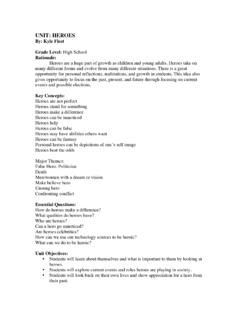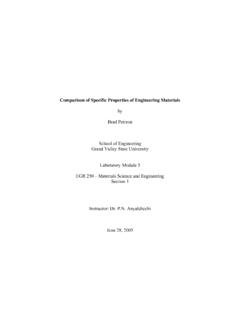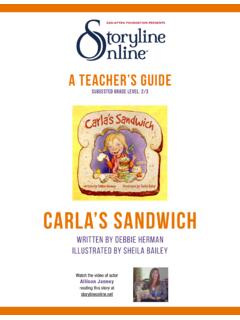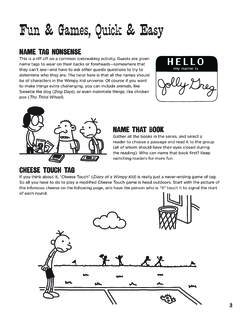Transcription of UNIT: HEROES
1 UNIT: HEROES By: Kyle Fleet Grade Level: High School Rationale: HEROES are a huge part of growth as children and young adults. HEROES take on many different forms and evolve from many different situations. There is a great opportunity for personal reflections, realizations, and growth in students. This idea also gives opportunity to focus on the past, present, and future through focusing on current events and possible elections. Key Concepts: HEROES are not perfect HEROES stand for something HEROES make a difference HEROES can be unnoticed HEROES help HEROES can be false HEROES may have abilities others want HEROES can be fantasy Personal HEROES can be depictions of one s self image HEROES beat the odds Major Themes: False Hero: Politician Death Men/women with a dream or vision Make believe hero Unsung hero Confronting conflict Essential Questions: How do HEROES make a difference? What qualities do HEROES have? Who are HEROES ? Can a hero go unnoticed?
2 Are HEROES celebrities? How can we use our technology sources to be heroic? What can we do to be heroic? Unit Objectives: Students will learn about themselves and what is important to them by looking at HEROES . Students will explore current events and roles HEROES are playing in society. Students will look back on their own lives and show appreciation for a hero from their past. Students will observe the role of the media and technology on celebrities and HEROES and relate it to their own lives. Integrated Studies Students will be looking into the mass media and it role on celebrities and HEROES . This lesson touches on history through lessons on aesthetics and critique. LESSON ONE Enduring Idea: HEROES Lesson Idea: Defining Hero Behavioral Objectives: 1. Students will give examples of someone they think of as a hero. 2. Students will write a short essay about their definition of what defines a hero. 3. Students will examine the power art has to create an alter ego and how that relates to the creation of superheroes.
3 4. Students will illustrate one superhero power that would be most beneficial to them and their world. Artists / Artworks / Sources: Kerry James Marshall o Rhythm Mastr Raymond Pettibon o Use of Gumby Materials / Supplies Paints Markers Paper Old Magazines Glue Scissors Instructional Strategies / Procedure 1. At the start of class ask the students, as a group, Who do you think of when you hear the word hero? As the students express their thoughts write their answers on the board. 2. Next ask the students, What characteristics do you think a hero should have? This time have them work individually. They will construct a small paragraph about what their definition of a hero is. This is a time for personal reflection away from the pressure of class critique. 3. Show the student s works of art by Kerry James Marshall and Raymond Pettibon. Point out the wonderful power art has to create any character for any situation. Art gives you the power to create anyone you feel needs to be created.
4 Essentially it gives you the ability to be anybody you want to be and solve any problem you want to. Through art you can bring to life an alter ego and live through your own creation, like Raymond Pettibon with Gumby. o Definition of Alter Ego: 1. Another side of oneself; a second self. 2. An intimate friend or a constant companion. As far as HEROES are concerned, solutions to a problem are endless along with the endless possibilities for creating a super hero. 4. Have the student s think of one problem in their lives that could use a superhero and illustrate it in a comic strip portraying one or more of the heroic qualities discussed in class that they feel is most appropriate for their situation. Take 10 min. to brainstorm by writing about any problem in your lives that could use a superhero. Then create a comic strip that addresses the problem and a super hero that fixes it. Be creative about your hero s superpowers and keep in mind that at the end of class you will be swapping comic strips and filling out a small critique about each others art work.
5 Their illustrations will be a mix of photo collage and markers or paint. Assessment When the students are all done they will swap illustrations with the person next to them and work through the assessment worksheet for this lesson. SUPERHERO CRITIQUE This section is to be filled out by someone other than the artist. 1. What superhero power has the artist given to their superhero? 2. What problem comes up in the comic and how does the superhero save the day? This Section is to be filled out by the artist. 1. Are your critic s answers correct? 2. If so, what design choices did you make that might have helped them in their interpretation of your piece? 3. If your critic was lead astray, what could you have done differently to better portray your idea? LESSON TWO Enduring Idea: HEROES Lesson Idea: History of HEROES and Celebrities Behavioral Objectives: 1. Students will read and discuss the essay Media and the Rise of Celebrity Culture by Amy Henderson.
6 2. Students will discuss the role of media and technology on fame. 3. Through researching Time s Top 100 People the students will gain knowledge of how people are using their fame to make a difference. Artists / Artworks / Sources: Media and the Rise of Celebrity By Amy Henderson Materials / Supplies THE TIME 100 Handout Student access to the Internet or a pile of printed articles on THE TIME 100 HEROES and pioneers. Celebrity / Hero presentation. Instructional Strategies / Procedure 1. Begin the class with an open forum where an image of a celebrity, hero, or someone who falls into both categories is projected in front of the class. When a new image shows up they have to say if that person is a celebrity or a hero and why. Each time I project a new image express to me if that person is a celebrity or hero and what your reason is for your decision. 2. After working through the slide show recap and lead into the next step by asking them, What is the difference between celebrities and HEROES ?
7 3. Work through and discuss the essay Media and the Rise of Celebrity, by Amy Henderson, as a class focusing on a few of the general parts hitting the general points. Have the students split into groups and assign each group a different part of the essay. When they are done reading through the essay have each group construct a summary and present the main present the main points of their section to the rest of the class. At this point it isn t important that they labor through the whole article, but grasp the main concept: In the past celebrities grew from heroism, but do to the rise of technology and the media celebrities arise from a high level of publicity. 4. Depending on the availability of a computers and access to the internet, have students either browse through the list of Time Magazine s Top 100 People or pull from a pile of already printed handouts. 5. Students will explore these people while filling out a simple handout on three that catch their attention.
8 THE TIME 100 [ HEROES & Pioneers] Hero Identification:_____ How have they found the spotlight? How have they used the spotlight? LESSON THREE Enduring Idea: HEROES Lesson Idea: Publicity and Heroism Behavioral Objectives: 1. Students will discuss the role of publicity on heroism. 2. Students will relate their own lives and their role in society to the bigger picture of celebrity HEROES . 3. The students will discuss the role of modern technology on their availability to publicity. 4. Students will make a poster using collage and a list of ways their access to technology can be used for heroism. Materials / Supplies Paints Colored Pencils Markers Scissors Glue Poster Board Scrap Magazines Instructional Strategies / Procedure 1. Begin the class by asking them to pull out their THE TIME 100 handouts from the previous class and briefly look over them in relation to the discussion that occurred around them. Go around the class and share about a person they picked and what they put on their worksheet.
9 6. Discuss the role of technology and relate it to their lives and their access to technology. The following questions can be used for this discussion. Does publicity provide a bigger voice? Can having a bigger voice give more influential power to the one who possesses it? How have the Time 100 HEROES and pioneers used their bigger voice and power to be heroic? Does the Internet and things like Facebook, Myspace, and Xanga allow for anyone to have more publicity or a bigger voice? Are there any forms of technology that provide this form of publicity to the general public? 3. Have the students look through magazines and pick out an advertisement. 4. Next ask the students to study the advertisement and write a paragraph about what message they feel that company is trying to send out using their access to publicity. 5. Use the rest of class for studio time where the students create a poster advertising a single solution or a list of solutions for how they can use Internet technology to be heroic.
10 LESSON FOUR Enduring Idea: HEROES Lesson Idea: Monuments and Memorial critique Behavioral Objectives: 1. Students will look at monumental works of art and describe what they see. 2. Students will gain knowledge of the subject being represented through researching the history around it. 3. The students will discuss/critique a specific piece. 4. Students will illustrate one heroic attribute of a person from their own lives with out using the actual person. Artists / Artworks / Sources Martin Puryear Ladder for Booker T Washington Maya Lin Vietnam Memorial Materials / Supplies Clay Instructional Strategies / Procedure 1. Start the class off by showing the students Ladder for Booker T. Washington and the Vietnam Memorial. Ask them a few questions to get them questioning he design choices the artists made. What do you think the ladder represents? Why is it shaped the way it is? Why is it wooden and not metal or plastic? Is the Vietnam memorial an appropriate choice?












